

The first evidence of Prehistoric seafarers of South Asia was found on Velanai Island in Jaffna.
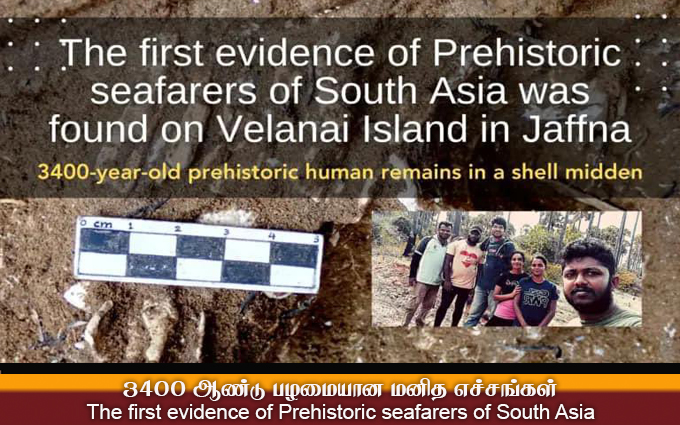
The first evidence of Prehistoric seafarers of South Asia was found on Velanai Island in Jaffna.
Archaeologists have found 3400-year-old prehistoric human remains in a shell midden on Jaffna Velanai Island. This is reported to be the first confirmed prehistoric human remains found in the Jaffna Peninsula. Researchers point out that the archaeological site with these data is located about one kilometer south of the well-known tourist attraction beach of Velanai Island.
3400-year-old prehistoric human remains in a shell midden
The research was led by Thilanka Siriwardana, a senior lecturer at the Department of Archaeology and Heritage Management, 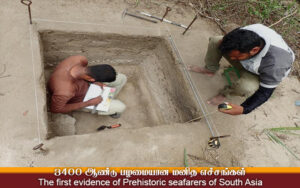 Rajarata University of Sri Lanka, in association with the Groningen Institute of Archaeology of the University of Groningen in the Netherlands, along with Indika Jayasekara, Janina Nonis, and Nadeera Dissanayake of the Institute of Archeology and Heritage Studies. This research series has been carried out since 2009 on the historical use of coastal resources in Sri Lanka and especially on the usage trends related to seashells. Accordingly, firstly, the southern coastal region of Sri Lanka, secondly, the north-western coastal area of Sri Lanka, and thirdly, the Jaffna Peninsula and the archipelago were studied, and that research series has made many discoveries in the field of archaeology in Sri Lanka. This has changed the scholarly opinion that there are no prehistoric human settlements in Jaffna and that the first settlement of Jaffna may have been done by a community belonging to the South Indian Megalithic culture.
Rajarata University of Sri Lanka, in association with the Groningen Institute of Archaeology of the University of Groningen in the Netherlands, along with Indika Jayasekara, Janina Nonis, and Nadeera Dissanayake of the Institute of Archeology and Heritage Studies. This research series has been carried out since 2009 on the historical use of coastal resources in Sri Lanka and especially on the usage trends related to seashells. Accordingly, firstly, the southern coastal region of Sri Lanka, secondly, the north-western coastal area of Sri Lanka, and thirdly, the Jaffna Peninsula and the archipelago were studied, and that research series has made many discoveries in the field of archaeology in Sri Lanka. This has changed the scholarly opinion that there are no prehistoric human settlements in Jaffna and that the first settlement of Jaffna may have been done by a community belonging to the South Indian Megalithic culture.
Research Team
Thilanka Siriwardena
Nadeera Dissanayake
Indika Jayasekara
Janina Nonis
Kanushtan
Dakshini and Susanthi
Senior Lecturer Thilanka Siriwardena, the primary researcher of this project, gave more details about this.
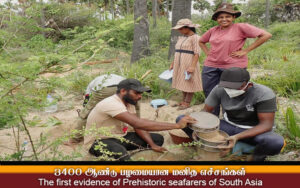 “IN THE RESEARCH DONE SINCE 2009, WE WERE STRONGLY CONVINCED THAT JAFFNA AND ITS ISLANDS CANNOT BE LACKING FROM PREHISTORIC HUMAN HABITATIONS. SIMILARLY, WE HYPOTHESIZED THAT IF ANY ORIGINAL EVIDENCE CAN BE OBTAINED, IT IS FROM THE COASTAL AREAS. THE SEA LEVEL GRADUALLY CHANGED AFTER THE LAST GLACIAL MAXIMUM, SUBMERGING THE OLDER HABITATIONAL EVIDENCE. WE IDENTIFIED MANY SUCH COASTAL SITES THROUGHOUT THIS
“IN THE RESEARCH DONE SINCE 2009, WE WERE STRONGLY CONVINCED THAT JAFFNA AND ITS ISLANDS CANNOT BE LACKING FROM PREHISTORIC HUMAN HABITATIONS. SIMILARLY, WE HYPOTHESIZED THAT IF ANY ORIGINAL EVIDENCE CAN BE OBTAINED, IT IS FROM THE COASTAL AREAS. THE SEA LEVEL GRADUALLY CHANGED AFTER THE LAST GLACIAL MAXIMUM, SUBMERGING THE OLDER HABITATIONAL EVIDENCE. WE IDENTIFIED MANY SUCH COASTAL SITES THROUGHOUT THIS
RESEARCH SERIES. ON THE COAST OF VELANAI ISLAND, WE OBSERVED THE SHELL MIDDENS, EVIDENCE OF ANCIENT HUMAN SETTLEMENTS IN MANY PLACES. AFTER THAT, WE DECIDED TO LAUNCH AN EXCAVATION AT ONE PLACE.”
Punguduthivi excavation
Shell middens are deposits made up of the shells of oysters consumed by humans. In some countries, these can be seen in large mounds. Also, in these deposits, the remains of other animals eaten by hunter-gatherers, tools, and, in some cases, evidence of the burial of dead bodies are found. These factors were primarily detected in Sri Lanka from the southern coast.
Those factors are also significant. The reason is that South Asian fields are still limited to Sri Lanka. By studying these deposits, we can uncover the environment, climate changes, seasonal basis, etc., by reconstructing the coastal people’s subsistence pattern. Our current research has yielded fossils of turtles, fish, and other land animals, stone tools, and bone tools.The most recent evidence of Sri Lanka’s pre-historic period is from Mantai, dating back to 1600 BC. With the dates we got from this excavation, we can bring the prehistoric era of Sri Lanka to a more recent stage by another two hundred years. Also, this research enables us to uncover much information different from the cultural factors with an agro-trade subsistence pattern received from those places, such as the beginning of permanent settlements in Jaffna, such as Kantarodai.
During the Velanai excavation
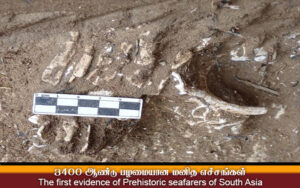 These facts about a prehistoric population migrating from time to the island of Velanai are a great discovery. They had some seafaring technology for those migrations. This excavation shows evidence that they brought quartz that was not found in Jaffna. We also found evidence of bone point that they used for spears, hooks, and harpoons. Fishing and other hunting of marine life with boats using such tools can still be seen among the tribal people of the Andaman Islands. It is also a technology owned by the aboriginal people of Australia.It can be assumed that these humans consumed not only marine resources but also land resources. At present, the Jaffna Peninsula has a dry, arid environment, but the environmental conditions during the prehistoric period were different from this. There are even written records that, at least in Jaffna, there was delicate vegetation with animals as early as 1700 AD. It can be assumed that a human community lived here during the prehistoric period, consuming these land and marine resources, and crossing the islands of Jaffna and the mainland using boats. Those factors are crucial. Instead of the idea that Indian culture was established in Sri Lanka by the merchant mariners from India, it can be highlighted that the seafaring prehistoric people may have maintained some contact with India. By then, various changes had already gradually spread to South India, i.e., agriculture, trade, and animal husbandry. These early seafarers may have received glimpses of such traits and were adapting to such cultural change.
These facts about a prehistoric population migrating from time to the island of Velanai are a great discovery. They had some seafaring technology for those migrations. This excavation shows evidence that they brought quartz that was not found in Jaffna. We also found evidence of bone point that they used for spears, hooks, and harpoons. Fishing and other hunting of marine life with boats using such tools can still be seen among the tribal people of the Andaman Islands. It is also a technology owned by the aboriginal people of Australia.It can be assumed that these humans consumed not only marine resources but also land resources. At present, the Jaffna Peninsula has a dry, arid environment, but the environmental conditions during the prehistoric period were different from this. There are even written records that, at least in Jaffna, there was delicate vegetation with animals as early as 1700 AD. It can be assumed that a human community lived here during the prehistoric period, consuming these land and marine resources, and crossing the islands of Jaffna and the mainland using boats. Those factors are crucial. Instead of the idea that Indian culture was established in Sri Lanka by the merchant mariners from India, it can be highlighted that the seafaring prehistoric people may have maintained some contact with India. By then, various changes had already gradually spread to South India, i.e., agriculture, trade, and animal husbandry. These early seafarers may have received glimpses of such traits and were adapting to such cultural change.
Dhakshini, Kanushtan and Thilanka
Dhakshini, Kanushtan and Thilanka
Accordingly, it can be suggested that the later Indian cultural influence flowed directly to a community undergoing some changes.
According to the factors obtained from this research series, the researchers are further of the opinion that these coastal communities show some adaptation compared to other contemporary communities in Sri Lanka.
In the first half of the research series, a shell midden belonging to this period (1450 BC) was identified from Hungama Kalamatiya, where the researchers could see evidence of a community that depended on stone tool technology. But among the Velanai islanders, the bone tools are more prominent. The researchers point out that it results from them adapting to working under regional environmental conditions for a long time.
Similarly, they assume that the later settlements, such as Anaikoddai and Kantarodai, may have been populated by the same maritime prehistoric people who engaged in this coastal subsistence pattern. The researchers point out that these three places’ drinking water and agricultural lands are more favourable for human development than other places in Jaffna.
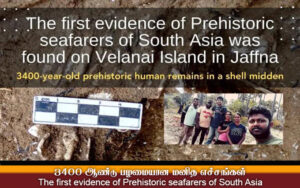 “IF WE PLACE THESE FACTORS TOGETHER WITH THE ANCIENT LEGENDS, WE KNOW THAT SEAFARING NAGA TRIBES CONSTANTLY REFER TO THIS REGION. PEOPLE WHO POSSESSED THIS CRAFT TECHNOLOGY MIGHT LIVE IN SRI LANKA AND INDIA. WE NEED FURTHER EVIDENCE TO STRENGTHEN THIS VIEW. HERE, WE SHOULD CONSIDER THAT MORE ANCIENT EVIDENCE FROM FARZAN ISLAND IN THE RED SEA SHOWS SIMILAR SEAFARING TRENDS IN THAT PART OF THE INDIAN OCEAN.
“IF WE PLACE THESE FACTORS TOGETHER WITH THE ANCIENT LEGENDS, WE KNOW THAT SEAFARING NAGA TRIBES CONSTANTLY REFER TO THIS REGION. PEOPLE WHO POSSESSED THIS CRAFT TECHNOLOGY MIGHT LIVE IN SRI LANKA AND INDIA. WE NEED FURTHER EVIDENCE TO STRENGTHEN THIS VIEW. HERE, WE SHOULD CONSIDER THAT MORE ANCIENT EVIDENCE FROM FARZAN ISLAND IN THE RED SEA SHOWS SIMILAR SEAFARING TRENDS IN THAT PART OF THE INDIAN OCEAN.
TAKING ALL THIS TOGETHER, WE CAN SEE THAT THERE MUST HAVE BEEN A COASTAL INTERACTION BETWEEN THE DIFFERENT PEOPLE WHO LIVED ALONG THE COAST OF THE INDIAN OCEAN AND THAT THE ORIGIN OF THE COMPLEX TRADE PATTERN AND CULTURAL EXPANSION PROCESS THAT DEVELOPED IN THE INDIAN OCEAN, LATER, MAY HAVE ARISEN FROM SUCH A COMMUNITY BASED ON LIMITED RESOURCES. THEY MAY GAIN THE CREDIT FOR CREATING THE TRADE VALUE OF SRI LANKA THAT WE FIND IN LATER PERIODS.
THEREFORE, RATHER THAN JUST FINDING THE EARLIEST PREHISTORIC EVIDENCE IN JAFFNA, THESE FINDINGS PROVIDE AN EXCELLENT OPPORTUNITY TO STUDY THE TRANSITION BETWEEN THE MESOLITHIC CULTURE AND THE EARLY IRON CULTURE AND HOW THE PEOPLE OF THE INDIAN OCEAN TRAVELLED BY SAILING.”
Therefore, they further express the opinion that these factors will be able to provide answers to some questions about the use of coastal resources in South Asia, how prehistoric humans used the coast to migrate to South Asia and Southeast Asia, etc. We would like to inform the readers that further analysis of the findings is progressing and will be communicated soon.
Dr. Canan Cakirlar of the Groningen Institute of Archaeology of the University of Groningen, Netherlands, Senior Lecturer Sivarubi of the Department of Archaeology and History of the University of Jaffna and the students of that department support this research.
This research was funded by the AHEAD scholarship grant of the Ministry of Higher Education, Technology and Innovation, Sri Lanka, and the Faculty of Humanities research grant of the University of Groningen.